Hard, untreated water containing high concentrations of minerals can cause damage to your plumbing and fixtures.
However, using a water softening system can help extend the life of your pipes, home appliances and provide a better water supply overall.
What Is Water Softener?
Water softener is a whole-house water filtration appliance that removes hard water minerals such as calcium and magnesium ions from water through an ion exchange process.
Having the best water softener system is important in many homes. It successfully treats water supply containing excess hard minerals before it reaches the home’s plumbing system. However, you can also find them in some office spaces and businesses in areas with extremely hard water.
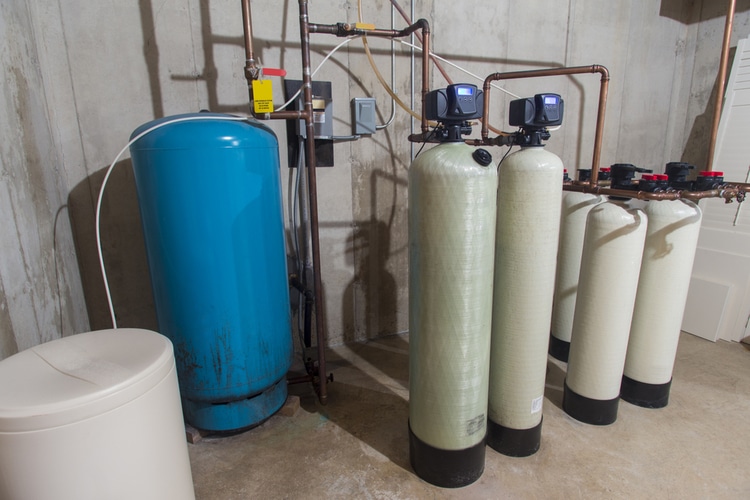
Operations of Water Softener: How Does It Work?
Water softeners work by removing hard water minerals through an ion exchange process.
Hard water deposits, such as calcium and magnesium, contain positively charged molecules.
Water softeners act similar to magnets by attracting these molecules and removing them from water that passes through the system. This involves an ion exchange process to help attract these minerals by using positive charges and negative molecules.
Therefore, hard minerals attract the negatively charged ions, allowing softer water to flow out of the unit and into your home.
Hard water will enter the home and go directly to the water softener unit into the mineral tank. Inside here sits a bed of resin beads that the water will pass through.
These spherical beads are typically polystyrene material and hold a negative charge, known as anions. They use sodium ions inside the water softener to receive a negative charge to reach this state.
Water containing excessive calcium and magnesium molecules will have a positive ion charge, also known as cations. In the simplest way possible, positive and negative forces attract, allowing these hard deposits to stick to the negatively charged resin beads.
Because these positive ion molecules have a stronger force than the sodium ions that sit on the resin beads, they overpower and take their place, releasing the sodium ions.
This ion exchange process successfully removes hard mineral content from the water, and it continues through the system into the home as soft water, with a minuscule amount of sodium ions.
However, the resin beads will eventually be full of positively charged ions from calcium and magnesium, so the water softener will need to perform a regeneration cycle to release these molecules and recharge the beads to continue to remove more hard mineral ions.
The Regeneration Process
The water softener regeneration process is how water softener eliminates positive ions stuck on the resin beads and then recharges them to hold a negative charge once more through ion exchange. This task ensures that it can continue reusing the beads to remove hardness minerals from water.
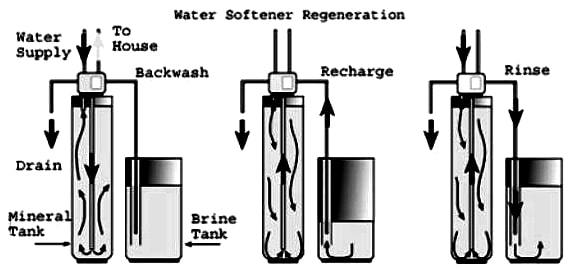
The type of system you have will determine how it completes the regeneration cycle. Salt-based water softeners are the most popular type for many homes.
Salt-Based Water Softener Regeneration
Depending on the model, there are two ways that a salt-based water softener can perform regeneration. Typically, with a saltwater softener, they include:
- Co-current regeneration: Downflow Brining where the solution flows down through the tank
- Con-current regeneration: Upflow Brining where the solution flows up through the mineral tank
A water softener runs through regeneration, typically in the late evening hours or early morning when everyone is asleep, and there is no need for water use. This way, it can effectively run when you need it during peak daytime hours.
The tank will have two parts: the reservoir tank and the secondary water softener salt storage compartment to complete the regeneration process correctly. This area is where homeowners will place the sodium chloride necessary to create the brine solution.
The brine solution enters the main tank to mix with the beads during regeneration. Because brine solution is a highly-concentrated salt solution, it forces the positive ion molecules on the beads to release. As a result, the negative ions from the brine mixture once again take their place on the beads.
The water that now contains hard minerals gets flushed out of the water softener through a wastewater drain. The unit also goes through a cleaning and sanitizing phase during regeneration as it prepares to remove hard water molecules once again effectively.
However, the regeneration process will be significantly different if you use a salt-free water softener.
Types of Water Softeners
Although salt-based water softeners are one of the most common models in use, it is not the only type available. Different homes and situations may require an alternative water softener type.
Here are the main types you will find in the market.
- Salt-based
- Salt-free
- Dual-tank
- Magnetic
- Citric Acid Water Softener
Salt-Based
Salt-based water softeners are highly versatile because they come in different sizes. Some models will work in your RV, while others are large enough to service an extensive estate. Of course, the unit’s total cost will directly reflect its maximum capacity.
These models use water softener salt to completely remove hard water minerals from the water by incorporating the ion-exchange process. Because they require the homeowner to add sodium chloride, they are generally larger than other types.
They also need a consistent supply and typically perform a regeneration process once a week, depending on the water you use.
Salt-Free
Naturally, salt-free water softeners don’t need the addition of salt to treat hard minerals in water that comes into your home. However, these units do not remove these hard water minerals, so it is not actually creating softened water.
Instead, a salt-free model conditions water by treating hard minerals, so they do not bind to your pipes or fixtures. This process, known as Template Assisted Crystallization (TAC), uses polymeric beads that crystalize calcium and hard water minerals.
It helps reduce soap scum or limescale build-up in your home.
Dual-Tank
As the name suggests, dual-tank water softeners use two reservoir tanks. While one tank is performing a regeneration process, the other tank can supply soft water as needed. These units are larger than other models and can be challenging to install in small spaces.
Dual-tank water softeners are ideal for homes that run on private wells because they have exceptional capabilities for removing excessive hard water minerals. These models can handle excessive water flows for large homes or businesses.
Magnetic
Magnetic water softener units sit on the water pipe, taking up less space than other models. They do not need access to the water but will need to use electricity.
Instead of using salt or crystallization, magnetic water softeners use electromagnetic coils to remove the positive charge of the hard minerals in water, neutralizing them.
This way, they cannot bind to surfaces that can cause damage to your plumbing system or fixtures. However, like the salt-free models, hard water minerals will still exist within the water, so these units act more as a water conditioner than a softener.
Components of a Water Softener System
A typical water softener system has several essential minerals to operate effectively. For this example, we will use the standard salt-based style.
A salt-based unit contains three main components for its operation. These include:
- The mineral tank
- The brine tank
- The control valve
The Mineral Tank
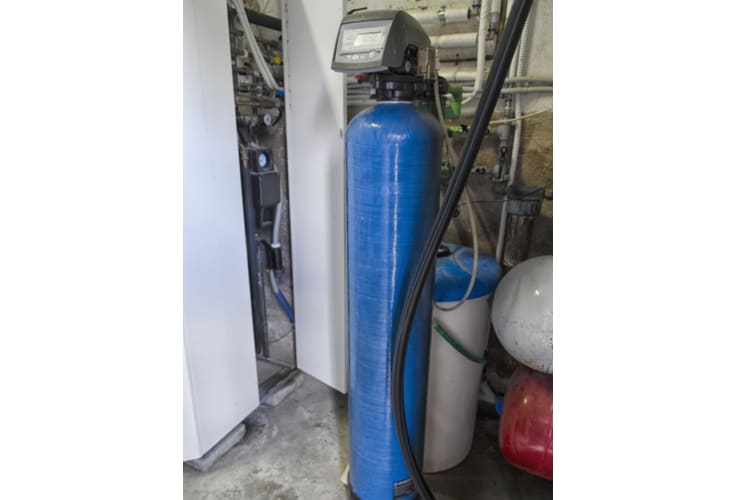
The mineral tank of a water softener is sometimes called the reservoir tank. It is where hard water supply enters the unit to flow through resin beads so it can effectively remove hard minerals and process softened water into the home.
The Brine Tank
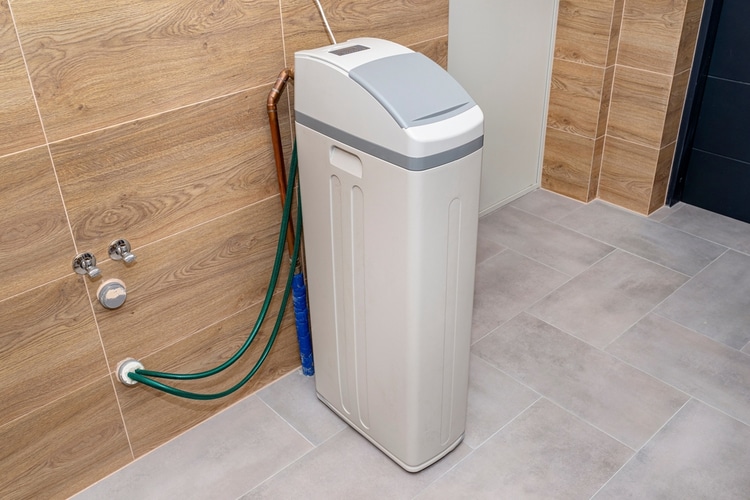
This is a secondary storage tank smaller than the main mineral tank. Brine tank holds the concentrated salt solution necessary for the regeneration process to restore the resin beads to a negative ion state.
The Control Valve
The control valve of a water softener helps measure the volume of soft water that passes from mineral tank and into the home. A water softener unit will have preset measurements that will regulate regeneration.
Once it reads larger water flow volumes, the unit will automatically initiate the regeneration process to return the resin beads to their optimal ion state.
Installation Cost and Maintenance Requirements
The cost of obtaining and maintaining a softener tank will depend on the type you choose for your home.
Each style of softener will also have individual maintenance requirements, so this element may be a contributing factor when selecting a new water softener model.
How Much Does It Cost to Buy?
If you need to purchase a new water softener, the final cost will vary depending on your style and needs. While budget can play a part in your final decision, you can expect to pay between $200 and $3,000 for a water softener unit.
- Salt-based models start around $300 for a low-end unit but can reach upward of $1,000
- Salt-free styles are slightly more expensive and start at about $500 for a low-end model and climb up to $3,000 for some units
- Dual-tank water softeners carry a more hefty price tag, starting at $1,000 and reaching $2,500 or more
- Magnetic units fall under a general price range between $200 and $400, depending on the model you choose
How Much Does It Cost to Install?
On average, homeowners can pay between $200 and $4,000 just to install their new water softener. But, of course, these prices will vary depending on the style of water softener, your home setup, and your location.
Many are surprised at how much they will pay to have a professional install their new unit in the home. Often, the original purchase of a water softener is not the only cost homeowners will incur.
- Salt-based water softeners can run you an additional $200 to $500 for installation
- Salt-free units are one of the more costly styles to install, ranging from $800 up to $4,000 for a professional to get the job done
- Dual-tank models can be slightly more tedious due to their grandiose size, but depending on the style and your house setup, you can pay between $300 and $1,000 for installation
- Magnetic types are one of the less expensive models to install, starting at only $200 but can reach up to $600
How Much Does It Cost to Maintain?
Maintenance costs for water softeners are relatively low for many newer models, where some may only cost a homeowner the price of electricity to run the unit each day. These systems will typically last up to 20 years or more and do not require much preventative maintenance until they see extensive use.
However, regular care and maintenance are vital for any household appliance, including water softeners. Proper maintenance will ensure the unit functions correctly and efficiently while extending its longevity.
- Salt-based water softeners require you to continually add salt for normal operation, although a 40-pound bag that will last a month on average can fall between $10 and $25. These styles also require electricity for operation, although it is minimal.
- Salt-free models do not require homeowners to add anything monthly but will require new TAC media every three to five years, depending on use. They do not need electricity or drainage valves for operation.
- Dual-tank styles are significantly larger, so they will require more salt than a standard-sized water softener. Because of their excessive use and size, they will need more electricity to operate.
- Magnetic units do not use other media as the other three styles do. Some models need to be installed directly into the home’s electricity for proper operation.
How Frequently Should I Maintain My Water Softener?
Water softeners will need regular maintenance and care to help keep them running efficiently. Annual checks and maintenance for critical parts (especially resin replacement) are crucial to help keep your unit running and prevent any potential problems in the future.
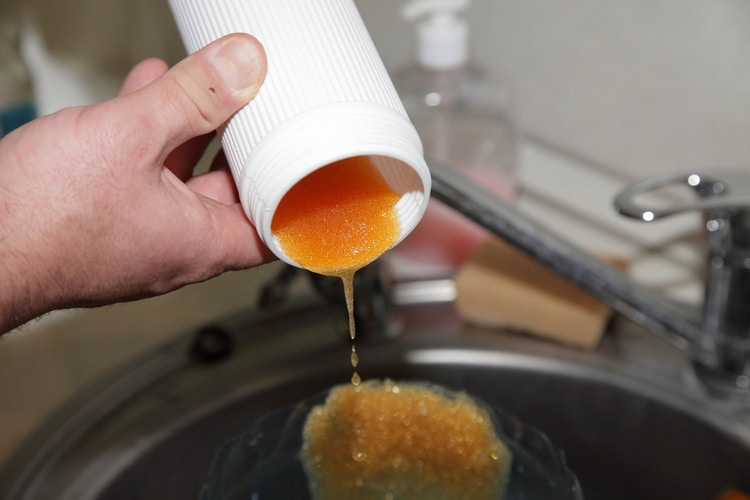
Water softeners can last 10 to 20 years or more, depending on how much you use them. However, they are a major household appliance, so you must check their operation each year to ensure it is still running efficiently.
Newer units will not need a thorough cleaning each year, thankfully, making it only necessary every five to ten years. Although, as the model ages, you may have to clean it yearly or every second year to ensure it operates effectively.
One critical aspect of owning a water softener is to ensure that it never runs out of salt. If it operates without salt in the tank, you risk damaging its internal components and your water will not be soft, creating more problems in your plumbing system and appliances, like washing machines.
Can I Install a Water Softener Myself?
It is possible to install a water softener yourself if you are comfortable tackling DIY projects. Of course, different styles of water softeners will vary in degree of difficulty when installing.
The type you choose may be relatively simple to install, while other models may take you an hour or two.
If you choose to install a water softener yourself, it can save you hundreds on the total cost since you will not use a professional service to get this job done. However, you must have the right tools and processes to complete the installation.
Pros & Cons of Water Softening
Having soft water can be a personal choice, or it may be necessary where you live. There are several water softener benefits and disadvantages to using one in your home.
- You minimize the chance of soap scum, limescale, and calcium build-up in your plumbing and throughout your home, including bathtubs, showers, sinks, and other fixtures
- You use less soap since it tends to lather better, providing a better cleaning experience for you and your home
- Appliances that use water, like water heaters, will last longer and run more efficiently
- Laundry and clothing will look and feel better
- Dishes will not have residue or watermarks even when clean
- Your skin and hair will not feel dry or itchy
- A water softener can increase the value of your home
- Water softeners do not remove bacteria or other harmful additives in the water
- Various units may not be beneficial for some individuals due to specific health reasons
- Some models have a detrimental impact on the environment
- Homeowners can spend thousands of dollars on a brand new water softener and professional installation
- Some individuals do not like how softened water feels after showering or bathing
- Some models are large and do not fit into smaller homes or spaces
- Electricity is necessary for some types of water softener units
What Are the Health Effects of Home Softening
For some individuals, a water softener can affect their health and well-being. Some of the more significant factors are listed here.
- If you have high blood pressure and are under a doctor’s recommendations to avoid sodium, you should opt for salt-free or magnetic water softeners. Otherwise, your blood pressure may rise.
- A daily reduction of calcium and magnesium from the water can make individuals deficient in these essential minerals that they do not get anywhere else.
What Are the Environmental Impacts of Home Softening?
There are some environmental impacts when using a water softener, unfortunately. These situations primarily happen when using the salt-based models since the brine discharge drains into the local septic lines.
It can also seep into the ground to septic systems and cause excessive sodium ion concentration in nearby aquatic areas. Another significant impact is the amount of water these units use during the regeneration process.
On average, a water softener will use an extra 50 gallons of water each week for this process, making the household water consumption higher than before.
How to Choose a Water Softener
When choosing a water softener, there are some important factors to decide which model will best suit your needs:
- The water hardness level of your current supply
- The size of your home and the number of individuals living in the home
- The available space for a water softener
- Your budget
- Your preference
1. The Hardness Level of Your Water
Knowing your water hardness will be the first step in determining what type of water softener to choose. For example, do you live in an area that receives well water full of hardness minerals? Does your water contain other undesirable contaminants that changes the odor and color?
If you are unsure what your water composition is, you can order test strips online or through a retailer. These items are inexpensive, and some retailers will provide them free of charge. Once you determine how hard your water is, next, you can start looking at other deciding factors to choose a water softener.
2. The Size of Your Home and Number of Individuals Living In the Home
Naturally, the size of your home and how many individuals will be using softened water will directly impact the type of water softener you should choose.
For example, if you live alone in an apartment, a small magnetic model may be sufficient for your needs. However, your water needs will be significantly more if you live in a large home with adults and multiple children. Everyday bathing, washing dishes and clothes, and even cleaning a more prominent space requires more soft water.
3. The Available Space for a Water Softener
The available space in your home to install a water softener can also help you determine what style will work best. While standard-sized homes often have a mechanical room suitable for a large unit, these models may not fit into a smaller condominium or an apartment.
4. Your Budget
Purchasing a major appliance can make a dent in your bank account. However, if you have hard water and are considering installing a water softener, your budget may narrow down your choices.
Before deciding on your equipment, part of the expense is installation, so if your budget is low, you may want to choose a model you can install yourself.
5. Your Preference
Personal preference will be vital when you choose a water softener. For example, do you want to continually add salt each month, or would you prefer a salt-free model? In addition, some styles will be more maintenance-free than others, so you must select a model you will be happy with in your home.
Popular Water Softener Brands
The market offers dozens of options to choose from when exploring different systems. Some popular water softener brands you will come across when shopping for a unit include:
- Springwell
- Waterboss
- Pentair Pelican
- Aquasana
- Fleck
- Whirlpool
Some brands will offer both salt-based and salt-free options, while others provide salt based or salt free alongside reverse osmosis filtration.
Common Questions
If you still have questions or concerns about purchasing a new water softener, here are some common questions relevant to your search.
Deciding which water softener method is best will depend on your preferences and needs. Some individuals may not have any concerns with the salt-based models.
However, these units do have some environmental factors that may have you looking at a salt-free option.
If you want to leave hardness minerals in the water without causing corrosion or build-up in your pipes, selecting a magnetic model may be your best choice.
If you live in an area with extremely hard water, using this equipment can be worth the money. This way, you can minimize the chances of plumbing damage, keep your home clean, and extend the life of your appliances.
In addition, softened water is easier for your clothes, skin, and hair.
Water softeners removes hard mineral elements that exist in water, including calcium, magnesium, and others. These molecules have binding properties that create the soap scum or mineral crust you find on showerheads, faucets, and other areas in your home.
If you do not have the space or budget to install a complete unit, there are some helpful alternatives.
These other choices include:
Liquid water softeners
Reverse osmosis systems
Water descalers
Depending on your hard water measurements, one of these options may work fine for your home and provide many of the same benefits as a standard system.
Water softeners will not remove existing calcium from pipes, unfortunately. These models can ensure that the build-up does not become worse, though.
If you want to remove calcium from pipes, choosing a salt-free model ensures the hard minerals are still in the water but become crystallized and can help break away existing calcium build-up.
Using a whole-house system will affect the toilet’s operation, however, in a positive way. There will be less chance of mineral build-up in the plumbing to effectively ensure the toilet flushes.
Softened water will also prevent hard water stains inside the toilet bowl or tank, which can be unsightly even if the toilet is clean.
If you are handy at DIY projects or are replacing an existing unit with a newer model, it is not difficult to do the installation yourself. Although, it may be more complicated if you do not have the correct tools or plumbing fixtures.
But if you want to save some money by installing one on your own, it is possible, with the proper tools and following the manufacturer’s instructions.
If you want to install a unit on your own, be sure to have all the necessary items on hand, including:
Plumbers tape
Slip joint pliers
Soldering torch
Tape measure
Tube cutter
Copper pipe
Copper tee
Fitting brush
Flux
Solder
Valves
Not all water softener installations will require all of these items, but you should refer to the instructions and check which tools and supplies are necessary before beginning the job.
The best place to put a water softener in a modern home will be at the point where water enters the home. It should be on level ground and is typically near the water heater tank in many houses. There should also be access to a drain.
It is accurate when you claim that hard water enters the unit and flows through resin beads so it can process softened water into the home and successfully remove hard minerals. My water is harder than 7 grains per gallon. I need a water softener to make sure my appliances function properly and to enhance the flavor, aroma, or appearance of my water.
Thanks so much for the explanation of how water softeners work and why they are helpful. My sister hates the way water sticks when she showers so she’s been wanting to get a water softener to give her better shower and cleaning experiences. We’ve been looking into how they work and what to know before we go looking to buy one.
Thank you for pointing out that salt-based water softeners’ several size options make them incredibly adaptable. The water in my home is hard, which is bad for my kids. I’ll arrange for the installation of a water softener system at my home.
I like what you said that the water hardness provides a different feeling for your home water. Yesterday, my cousin informed me he and his wife intend to have a water softener in their home for safe drinking water. He asked if I had any recommendations for the best option. I’ll tell him consulting a water softener service is much better because they can answer all their concerns. I’m grateful for this instructive article.
It’s helpful to know what we’d consider before choosing a water softener for our home. We moved to another house last month, but we suspect that it has a hard water issue since all the fixtures keep getting stained, so we’ll follow your advice to fix it. We appreciate your information on thinking about our house’s size when picking a type of water softener.